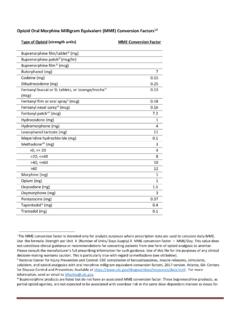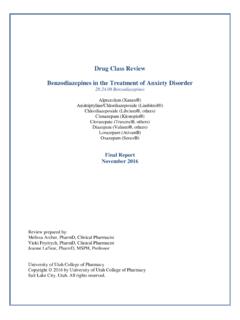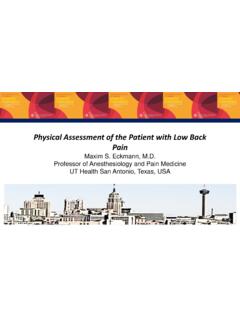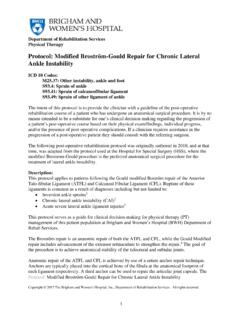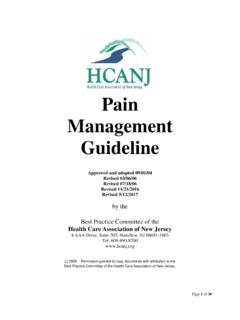Transcription of Skeletal Muscle Relaxants Drug Class Review
1 Skeletal Muscle Relaxants Drug Class Review 12 Centrally Acting Skeletal Muscle Relaxants Baclofen (Lioresal , others) FDA Approved 1982 Carisoprodol (Soma , others) FDA Approved 1959 Carisoprodol/Aspirin (Soma Compound , others) FDA Approved 1983 Carisoprodol/Aspirin/Codeine (Soma Compound with Codeine , others) FDA Approved 1983 Chlorzoxazone (Parafon Forte , Lorzone , others) FDA Approved 1958 Cyclobenzaprine (Flexeril , others) FDA Approved 1977 Dantrolene (Dantrium , others) FDA Approved 1974 Metaxalone (Skelaxin , others) FDA Approved 1962 Methocarbamol (Robaxin , others) FDA Approved 1957 Orphenadrine (Norflex , others) FDA Approved 1959 Orphenadrine/Aspirin/Caffeine (Orphenadrine Compound ) FDA Approved 1996 Tizanidine (Zanaflex , others) Approved 1996 Final Report February 2016 Review prepared by: Vicki Frydrych, BS, PharmD, Clinical Pharmacist Gary Oderda, PharmD, MPH, Professor University of Utah College of Pharmacy Copyright 2016 by University of Utah College of Pharmacy Salt Lake City, Utah.
2 All rights reserved. 2 Table of Contents Executive Summary .. 3 Introduction .. 5 Disease Overview .. 6 Table 1. Comparison of the Skeletal Muscle 7 Place in Therapy Guidelines .. 11 Table 2. Summary of Current Clinical Practice Guidelines for Skeletal Muscle Relaxants .. 11 Pharmacology .. 12 Pharmacokinetics .. 13 Table 3. Pharmacokinetics of the Skeletal Muscle Relaxants16,17,34 .. 14 Methods .. 16 Special 16 Table 4: Dosing Recommendations for Use of Skeletal Muscle Relaxants in Special Populations 17,20,35,37,38 .. 17 Safety .. 19 Table 5 Safety of the Skeletal Muscle Relaxants * 5,16,20,34,38,68,75 .. 20 Withdrawal Reactions .. 22 Agent Specific Information.
3 22 Adherence .. 24 Potential for Abuse .. 24 Drug Interactions .. 25 Table 6. Drug Interactions with the Skeletal Muscle Relaxants .. 26 Clinical Evidence .. 27 Summary .. 30 References .. 32 Appendix I: Comparative Efficacy for Skeletal Muscle Relaxants : Systematic Review9 .. 36 Appendix II: Comparative Safety of Skeletal Muscle Relaxants Systematic Review9 .. 37 Appendix III: Clinical Evidence for Skeletal Muscle Relaxants : Systematic Review81 .. 38 Appendix IV: Clinical Evidence for Skeletal Muscle Relaxants : Anti-spasticity Agents in Children73,74 .. 40 3 Executive Summary Introduction: pain is the most common reason people enter the health care system.
4 The presence of low back pain remains among the top 5 reasons for primary physician visits. Three of the Skeletal Muscle Relaxants , carisoprodol, cyclobenzaprine and metaxalone comprise 45% of all prescriptions for lower back pain . This heterogeneous group of agents are useful in the treatment of musculoskeletal disorders associated with spasticity resulting from upper motor neuron disorders or in the treatment of peripheral musculoskeletal disorders associated with Muscle pain or spasm. No clinical practice guideline suggests using a Skeletal Muscle relaxant as first-line therapy for the treatment of pain or spasm.
5 These agents are indicated as adjunct or alternative therapy after first or second line therapies have failed. Virtually every guideline points out the adverse effect profile (including abuse potential) of these agents and suggests caution in patient selection. For the treatment of spasticity baclofen is considered a first line agent with dantrolene and tizanidine generally recommended second line. Clinical Efficacy: There are few comparative trials. Many initial clinical trials were published in in the 1960 s to 1970 s and were of poor quality. Trials often did not define the use of concomitant medications, pre-study treatment, many were not double-blind, and among other issues, the term Muscle -spasm was not well defined.
6 The data supporting many of these agents is weak. Data supporting the use of combination products is rare. Efficacy appears to decline over time particularly for Muscle pain and spasm. No data clearly demonstrated an advantage over non-steroidal anti-inflammatory drugs or when used in combination with them. The agents with the least clinical evidence supporting their use include chlorzoxazone, methocarbamol, dantrolene and baclofen for pain and spasm. Carisoprodol and cyclobenzaprine offer more evidence supporting their use for Muscle pain and spasm. Only tizanidine, dantrolene and baclofen have evidence supporting their use in spasticity.
7 Adverse Drug Reactions: In general, these agents are associated with significant side effects. Anticholinergic symptoms including sedation, somnolence and dry mouth occur commonly. All the antispasmodics are considered potentially unsafe for use in the elderly according to the most current Beers criteria list. Hepatotoxicity is problematic for some medications while abuse potential and withdrawal reactions are noted with others. Summary: Evidence does seem to support the efficacy of cyclobenzaprine and carisoprodol for the treatment of Muscle pain and spasm. Overall, these agents have limited evidence supporting their short-term use with virtually no data suggesting any agent offers long-term benefits.
8 They are not considered first-line therapy in the indications for which they have approval and most carry the 4 risk potential for significant adverse events and/or abuse potential. These agents should be used judiciously with careful consideration of patient-related variable in their selection and careful monitoring of these agents in use. 5 Introduction The most common reason people enter the health care system is the presence of Low back pain remains among the top 5 reasons primary physician office Musculoskeletal disorders are responsible for 20% of outpatient visits in the US yearly (>315 million).6 Most acute musculoskeletal pain is non-specific, and resolve within 4 weeks.
9 When pain extends beyond 3 months it significantly affects quality of life and health care utilization and The direct medical costs associated with back pain in 1990 exceeded $24 Skeletal Muscle Relaxants constitute of prescriptions written for musculoskeletal pain making them the most common drug Class prescribed for musculoskeletal Three of the agents carisoprodol, cyclobenzaprine and metaxalone comprise 45% of all prescriptions for lower back According to data from Symphony Health Solutions four of the Skeletal Muscle Relaxants are among the top 200 medications dispensed in 2014. Cyclobenzaprine is #35 with million prescriptions, tizanidine is #107 with million prescriptions, carisoprodol is #122 with million prescriptions and methocarbamol is #150 with 6 million prescriptions dispensed in Skeletal Muscle Relaxants include a heterogeneous mix of agents with differing structures and generally undefined mechanism of action.
10 These agents are typically classified as antispasticity (baclofen, dantrolene) or antispasmodic agents (carisoprodol, chlorzoxazone, cyclobenzaprine, metaxalone, methocarbamol, and orphenadrine. Antispasticity agents have activity in upper motor syndromes ( multiple sclerosis, cerebral palsy, traumatic brain injury, spinal cord injury and post-stroke syndrome) while the antispasmodics are used for peripheral Muscle pain and spasm. Tizanidine demonstrates both activities. 7,9 Antispasmodic Skeletal Muscle Relaxants are generally considered second-line or adjunct therapy for musculoskeletal pain when initial therapy fails.)




